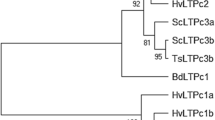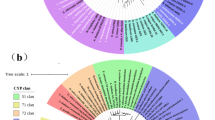Abstract
Key message
Pru p 3, a peach LTP, is located in pollinated flower styles and secreting downy hairs, transporting a derivative of camptothecin bound to phytosphingosine. Pru p 3 may inhibit a second pollination and may keep away herbivores until seed maturation.
Abstract
The allergen Pru p 3, a peach lipid transfer protein, has been well studied. However, its physiological function remains to be elucidated. Our results showed that Pru p 3 usually carries a lipid ligand that play an essential role in its function in plants. Using ESI-qToF, we observed that the ligand was a derivative of camptothecin binding to phytosphingosine, wich that is inserted into the hydrophobic tunnel of the protein. In addition, the described ligand displayed topoisomerase I activity inhibition and self-fluorescence, both recognized as camptothecin properties. During flower development, the highest expression of Pru p 3 was detected in the styles of pollinated flowers, in contrast to its non-expression in unpollinated pistils, where expression decreased after anthesis. During ripening, the expression of Pru p 3 were observed mainly in peel but not in pulp. In this sense, Pru p 3 protein was also localized in trichomes covering the fruit epidermis.







Similar content being viewed by others
References
Bonghi C et al (2011) A microarray approach to identify genes involved in seed-pericarp cross-talk and development in peach. BMC Plant Biol 11:107
Borges JP, Jauneau A, Brule C, Culerrier R, Barre A, Didier A, Rouge P (2006) The lipid transfer proteins (LTP) essentially concentrate in the skin of Rosaceae fruits as cell surface exposed allergens. Plant Physiol Biochem 44:535–542
Botton A, Begheldo M, Rasori A, Bonghi C, Tonutti P (2002) Differential expression of two lipid transfer protein genes in reproductive organs of peach (Prunus persica L. Batsch). Plant Sci 163:993–1000
Botton A, Andreotti C, Costa G, Ramina A (2009) Peach (Prunus persica L. Batsch) allergen-encoding genes are developmentally regulated and affected by fruit load and light radiation. J Agricu Food Chem 57:724–734
Chae K, Gonong BJ, Kim SC, Kieslich CA, Morikis D, Balasubramanian S, Lord EM (2010) A multifaceted study of stigma/style cysteine-rich adhesin (SCA)-like Arabidopsis lipid transfer proteins (LTPs) suggests diversified roles for these LTPs in plant growth and reproduction. J Exp Bot 61:4277–4290
Charvolin D, Douliez JP, Marion D, Cohen-Addad C, Pebay-Peyroula E (1999) The crystal structure of a wheat nonspecific lipid transfer protein (ns-LTP1) complexed with two molecules of phospholipid at 2.1 A resolution. Eur J Biochem/FEBS 264:562–568
Dardick CD, Callahan AM, Chiozzotto R, Schaffer RJ, Piagnani MC, Scorza R (2010) Stone formation in peach fruit exhibits spatial coordination of the lignin and flavonoid pathways and similarity to Arabidopsis dehiscence. BMC Biol 8:13
Diaz-Perales A et al (2000) Lipid-transfer proteins as potential plant panallergens: cross-reactivity among proteins of Artemisia pollen, Castanea nut and Rosaceae fruits, with different IgE-binding capacities. Clin Exp Allergy 30:1403–1410
Diaz-Perales A, Garcia-Casado G, Sanchez-Monge R, Garcia-Selles FJ, Barber D, Salcedo G (2002) cDNA cloning and heterologous expression of the major allergens from peach and apple belonging to the lipid-transfer protein family. Clin Exp Allergy 32:87–92
Dudareva N, Pichersky E, Gershenzon J (2004) Biochemistry of plant volatiles. Plant Physiol 135:1893–1902
Garrido-Arandia M, Gomez-Casado C, Diaz-Perales A, LF P (2014) Molecular Dynamics of major allergens from Alternaria, birch pollen and peach. Mol Inf 33:682–694
Hamilton JA (2004) Fatty acid interactions with proteins: what X-ray crystal and NMR solution structures tell us. Prog Lipid Res 43:177–199
Herrero M, Arbeloa A (1989) Influence of the pistil on pollen tube kinetics in peach (Prunus persica (L.) Batsch). Am J Bot 176:1441–1447
Isah T, Mujib A (2015) Camptothecin from Nothapodytes nimmoniana: review on biotechnology applications. Acta Physiologiae Plantarum 37:1–14
Kader JC (1996) Lipid-transfer proteins in plants. Annu Rev Plant Physiol Plant Mol Biol 47:627–654
Kulkarni AV, Patwardhan AA, Lele U, Malpathak NP (2010) Production of camptothecin in cultures of Chonemorpha grandiflora. Pharmacognosy Res 2:296–299
Lombardo VA et al (2011) Metabolic profiling during peach fruit development and ripening reveals the metabolic networks that underpin each developmental stage. Plant Physiol 157:1696–1710
Lorence A, Nessler CL (2004) Camptothecin, over four decades of surprising findings. Phytochemistry 65:2735–2749
Molina A, Garcia-Olmedo F (1993) Developmental and pathogen-induced expression of three barley genes encoding lipid transfer proteins. Plant J 4:983–991
Pacios LF, Gomez-Casado C, Tordesillas L, Palacin A, Sanchez-Monge R, Diaz-Perales A (2012) Computational study of ligand binding in lipid transfer proteins: structures, interfaces, and free energies of protein-lipid complexes. J Comput Chem 33:1831–1844
Palacin A et al (2012) Graph based study of allergen cross-reactivity of plant lipid transfer proteins (LTPs) using microarray in a multicenter study. PloS One 7:e50799
Pasquato N, Berni R, Folli C, Folloni S, Cianci M, Pantano S, Helliwell JR, Zanotti G (2006) Crystal structure of peach Pru p 3, the prototypic member of the family of plant non-specific lipid transfer protein pan-allergens. J Mol Biol 356(3):684–694
Pettersen EF, Goddard TD, Huang CC, Couch GS, Greenblatt DM, Meng EC, Ferrin TE (2004) UCSF Chimera—A visualization system for exploratory research and analysis. J Comput Chem 25(13):1605–1612
Phillips JC, Braun R, Wang W, Gumbart J, Tajkhorshid E, Villa E, Chipot C, Skeel RD, Kalé L, Schulten K (2005) Scalable molecular dynamics with NAMD. J Comput Chem 26(16):1781–1802
Salcedo G, Sanchez-Monge R, Barber D, Diaz-Perales A (2007) Plant non-specific lipid transfer proteins: an interface between plant defence and human allergy. Biochim Biophys Acta 1771:781–791
Salminen TA, Blomqvist K, Edqvist J (2016) Lipid transfer proteins: classification, nomenclature, structure, and function. Planta 244:971–997
Shin JH et al (2014) A lipidomic platform establishment for structural identification of skin ceramides with non-hydroxyacyl chains. Anal Bioanal Chem 406:1917–1932
Sirikantaramas S, Taura F, Tanaka Y, Ishikawa Y, Morimoto S, Shoyama Y (2005) Tetrahydrocannabinolic acid synthase, the enzyme controlling marijuana psychoactivity, is secreted into the storage cavity of the glandular trichomes. Plant Cell Physiol 46:1578–1582
Sirikantaramas S, Sudo H, Asano T, Yamazaki M, Saito K (2007) Transport of camptothecin in hairy roots of Ophiorrhiza pumila. Phytochemistry 68:2881–2886
Sossountzov L et al (1991) Spatial and temporal expression of a maize lipid transfer protein gene. Plant Cell 3:923–933
Sun Y et al (2011) Pyrosequencing of the Camptotheca acuminata transcriptome reveals putative genes involved in camptothecin biosynthesis and transport. BMC Genom 12:533
Thoma S, Kaneko Y, Somerville C (1993) A non-specific lipid transfer protein from Arabidopsis is a cell wall protein. Plant J 3:427–436
Tordesillas L et al (2013) Transport of Pru p 3 across gastrointestinal epithelium-an essential step towards the induction of food allergy? Clin Exp Allergy 43:1374–1383
Trott O, Olson AJ (2010) AutoDock Vina: improving the speed and accuracy of docking with a new scoring function, efficient optimization, and multithreading. J Comput Chem 31:455–461
Wen-Zhe L (2004) Secretory Structures and Their Relationship to Accumulation of Camptothecin in Camptotheca acuminata (Nyssaceae). Acta Botanica Sinica 46:1242
Wink M (2003) Evolution of secondary metabolites from an ecological and molecular phylogenetic perspective. Phytochemistry 64:3–19
Wright CM, van der Merwe M, DeBrot AH, Bjornsti MA (2015) DNA topoisomerase I domain interactions impact enzyme activity and sensitivity to camptothecin. J Biol Chem 290:12068–12078
Zachowski A, Guerbette F, Grosbois M, Jolliot-Croquin A, Kader JC (1998) Characterisation of acyl binding by a plant lipid-transfer protein. Eur J Biochem 257:443–448
Zhao C, Li C, Wang L, Zu Y, Yang L (2010) Determination of camptothecin and 10-hydroxycamptothecin in camptotheca acuminata by lc-esi-ms/ms. Anal Lett 43:2681–2693
Zoette V, Cuendet MA, Grossdidier A, Michielin O (2011) SwissParam, a fast force field generation tool for small organic molecules. J Comput Chem 32:2359–2368
Acknowledgements
The authors thank the Centro de Supercomputación y Visualización de Madrid (CeSViMa) and Centre for Metabolomics and Bioanalysis (CEMBIO) for computing resources and technical assistance. The study was supported by the Ministry of Science and Innovation (project BIO2013-041403-R) and FIS-Thematic Networks and Co-operative Research Centres: RIRAAF (RD12/0013/0014). The funders had no role in the study design, data collection and analysis, the decision to publish, or the preparation of the manuscript.
Author contributions
Sample collection: MH; Experimental design and analysis of results: PGM, MH, LFP, AD-P; Experimental development: NCB, CGC, LT; Modelling and molecular dynamics analysis: MGA, LFP; Confocal microscopy: CRC, PGM.
Author information
Authors and Affiliations
Corresponding author
Ethics declarations
Conflict of interest
The authors declare that they have no competing interests.
Rights and permissions
About this article
Cite this article
Cubells-Baeza, N., Gómez-Casado, C., Tordesillas, L. et al. Identification of the ligand of Pru p 3, a peach LTP. Plant Mol Biol 94, 33–44 (2017). https://doi.org/10.1007/s11103-017-0590-z
Received:
Accepted:
Published:
Issue Date:
DOI: https://doi.org/10.1007/s11103-017-0590-z




